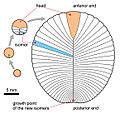Dickinsonia facts for kids
Quick facts for kids Dickinsonia |
|
|---|---|
 |
|
| Cast of Dickinsonia costata from Australia | |
| Scientific classification |
|
| Kingdom: | Animalia |
| Clade: | Bilateria |
| Phylum: | †Proarticulata |
| Family: | †Dickinsoniidae |
| Genus: | †Dickinsonia Sprigg, 1947 |
| Species | |
|
See text |
|
| Synonyms | |
|
|
Dickinsonia is an ancient type of life from the Ediacaran period. This was a time long before the dinosaurs, about 571 to 541 million years ago. These creatures looked very different from animals we see today. They are thought to be some of the earliest multicellular organisms, meaning they were made of many cells, not just one.
Dickinsonia's bodies were shaped like flat discs. Fossils show they could be tiny, about four millimeters, or quite large, up to 1.4 meters across! But they were only a few millimeters thick. Their bodies had a central groove and many smaller grooves branching out, making them look segmented. They also had symmetric bodies, meaning one side mirrored the other. Scientists have found different shapes and sizes of these fossils, which helps them classify Dickinsonia into various species.
These ancient creatures probably did not swim around on their own. Instead, they likely floated with ocean currents. Some scientists think they might have been able to stick to the ocean floor. Their feeding style was probably similar to modern-day placozoa, which are very simple animals that absorb food directly through their bodies.
Contents
What Was Dickinsonia?
For a long time, scientists weren't sure how to classify Dickinsonia. They compared them to many different modern animals. Some thought they might be like jellyfish or marine worms. Others even suggested they were related to chordates, which include animals with a backbone. Because of how they might have fed, some thought they were similar to Placozoa. There was even a theory that they lived in a special partnership with organisms that used photosynthesis, like lichens do today. If this were true, they might have been a type of fungi.
Dickinsonia Was an Animal
In 2018, a big discovery helped solve the mystery. Scientists studied Dickinsonia fossils very closely. They found special fats called cholesteroids inside the fossils. These fats are found only in animals. This discovery was very important because it showed that Dickinsonia were indeed early animals.
This finding supports the idea that the Ediacaran biota, which includes Dickinsonia, might have been the first step towards the huge variety of animal life that appeared later in the Cambrian period, about 500 million years ago. The Ediacaran biota includes the first complex organisms large enough to be seen without a microscope.
How Dickinsonia Was Discovered
The first fossils of Dickinsonia were found in the 1940s in the Flinders Ranges of Australia. A paleontologist named Reginald Sprigg published the first scientific paper about them in 1947. Sprigg named the genus after Ben Dickinson, who was in charge of the Mines of South Australia at the time.
When Sprigg first found them, he thought he had discovered a fossilized jellyfish. Over the years, other scientists tried to classify Dickinsonia. In 1956, Harrington and Moore also thought they were Cnidarians (like jellyfish). Then, in 1966, they were classified as Annelids, which are segmented worms. However, most Annelid fossils look quite different from Dickinsonia. Because of these different ideas, scientists continued to debate how to classify Dickinsonia for many years.
Images for kids
See also
 In Spanish: Dickinsonia para niños
In Spanish: Dickinsonia para niños




